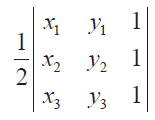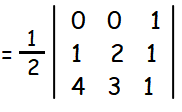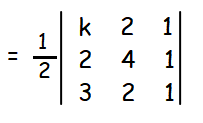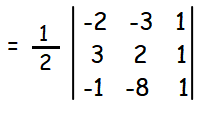AREA OF TRIANGLE USING DETERMINANT FORMULA
Subscribe to our ▶️ YouTube channel 🔴 for the latest videos, updates, and tips.
Here we are going to see, how to find the area of a triangle with given vertices using determinant formula.
We know that the area of a triangle whose vertices are (x1 , y1),(x2 , y2) and (x3 , y3) is equal to the absolute value of
(1/2) [x1 y2 - x2y1 + x2y3 - x3y2 + x3y1 - x1y3]
This expression can be written in the form of a determinant as shown below.

Note :
The area of the triangle formed by three points is zero if and only if the three points are collinear.
Also, we remind the reader that the determinant could be negative whereas area is always non negative.
Practice Problems
Problem 1 :
Find the area of the triangle whose vertices are (0, 0), (1, 2) and (4, 3).
Solution :
Let the point be (x1, y1) ==> (0, 0), (x2, y2) ==> (1, 2) and (x3, y3) ==> (4, 3)

= (1/2)[3 - 8]
= (1/2)[-5]
= 5/2
= 2.5
Area cannot be represented with negative. So, area of the triangle with given vertices is 2.5 square units.
Problem 2 :
If (k, 2), (2, 4) and (3, 2) are vertices of the triangle of area 4 square units then determine the value of k.
Solution :
Area of triangle = 4 square units

(1/2){k [4 - 2] - 2[2 - 3] + 1[4 - 12] } = 4
k(2) - 2(-1) + 1(-8) = 8
2k + 2 - 8 = 8
2k - 6 = 8
2k = 8 + 6
2k = 14
k = 7
So, the value of k is 7.
Problem 3 :
Find the area of the triangle whose vertices are (-2, -3), (3, 2), and (-1, -8).

= (1/2) [ -2(2 + 8) + 3(3+1) + 1(-24 + 2) ]
= (1/2) [-2 (10) + 3(4) + 1(-22)]
= (1/2) [ -20 + 12 - 22]
= (1/2) [ -42 + 12]
= (1/2) (-30)
= -15
So, the required area is 15 square units.
Subscribe to our ▶️ YouTube channel 🔴 for the latest videos, updates, and tips.
Kindly mail your feedback to v4formath@gmail.com
We always appreciate your feedback.
About Us | Contact Us | Privacy Policy
©All rights reserved. onlinemath4all.com

Recent Articles
-
US Common Core K-12 Curricum Algebra Solving Simple Equations
Jan 07, 26 01:53 PM
US Common Core K-12 Curricum Algebra Solving Simple Equations -
10 Hard SAT Math Questions (Part - 4)
Jan 05, 26 06:56 PM
10 Hard SAT Math Questions (Part - 4) -
10 Hard SAT Math Questions (Part - 3)
Jan 05, 26 06:34 PM
10 Hard SAT Math Questions (Part - 3)

